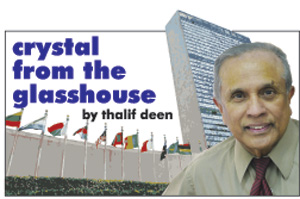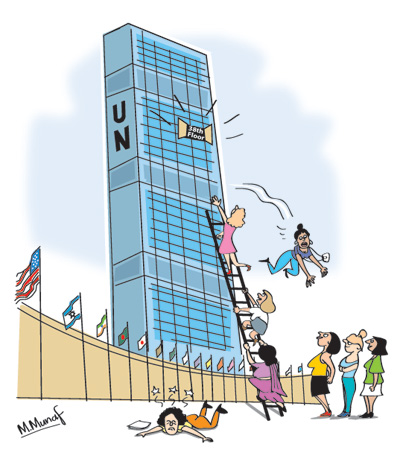Sunday Times 2
The elusive search for a female UN chief
View(s):UNITED NATIONS – When South Korean Foreign Minister Ban Ki-moon was elected UN Secretary-General in late 2006 and took office in January 2007, he was the eighth male to hold the office in a slate of predominantly all-male candidates.
 The only female candidate, Latvian President Vaira Vike-Freiberga, never made it to the 38th floor of the UN Secretariat prompting an Asian diplomat to weigh in with an upgraded Biblical quote with a political twist: It is easier for a camel to pass through the eye of a needle, he said, than for a woman to become the Secretary-General of the United Nations.
The only female candidate, Latvian President Vaira Vike-Freiberga, never made it to the 38th floor of the UN Secretariat prompting an Asian diplomat to weigh in with an upgraded Biblical quote with a political twist: It is easier for a camel to pass through the eye of a needle, he said, than for a woman to become the Secretary-General of the United Nations.
But as an unrelated New Yorker cartoon will have it: “We (may still) need either bigger needles or smaller camels.”
The other six candidates in that race for UN chief were all men: UN Under-Secretary-General Shashi Tharoor of India; former Foreign Minister Ashraf Ghani of Afghanistan; Jordanian Ambassador Prince Zeid Raad al-Hussein; Thai Deputy Prime Minister Surakiart Sathirathai; UN Under-Secretary-General and former Sri Lankan Ambassador Jayantha Dhanapala and Ban Ki-moon (who, in a straw poll, received 14 of the 15 votes in the Security Council before official voting and confirmation by the General Assembly).
 At that election, the Latvian female candidate was not taken seriously because it was Asia’s turn for the job of UN chief — and all the male candidates were from Asia, and there wasn’t a single woman candidate from Asia (not even our own Radhika Coomaraswamy, the triple Ivy leaguer, and the highest ranking Sri Lankan woman at the UN, later holding the title of Under-Secretary-General).
At that election, the Latvian female candidate was not taken seriously because it was Asia’s turn for the job of UN chief — and all the male candidates were from Asia, and there wasn’t a single woman candidate from Asia (not even our own Radhika Coomaraswamy, the triple Ivy leaguer, and the highest ranking Sri Lankan woman at the UN, later holding the title of Under-Secretary-General).
At the height of the election campaign, one of the frontrunners was asked what he thought of a proposal from a non-governmental organisation (NGO) for a female Secretary-General. And he replied rather flippantly: “Well, it is too late for me to change sex.”
But that was long before a seeded tennis player in New York underwent sex reassignment surgery — from a man to a woman — triggering a joke that she would be the world’s first tennis player who could play mixed doubles with herself. But no such luck with the UN Secretary-General even though the UN continues to be a vibrant supporter of lesbian, gay, bisexual and transgender (LGBT) rights.
For most of the 70 years of its existence, the UN has remained mostly male dominated as part of its political culture. In the 1960s, when gender discrimination was widespread at the United Nations, there was a story doing the rounds of a woman candidate who had applied for a mid-level professional job in the UN Secretariat.
She was armed with a Master’s Degree from an American university and perhaps eminently qualified for the job she was seeking. But at the end of the interview, she was asked: “But can you type?”
In a chauvinistic male-dominated Secretariat of a bygone era, women were being stereotyped and earmarked mostly for secretarial jobs while the men held all, of most, of the decision-making jobs in the UN hierarchy. Last month, UN Secretary-General Ban Ki-moon cited a famous memoir, appropriately titled “Never Learn to Type,” written by Dame Margaret Anstee, a former senior UN official.
Anstee, who served at the United Nations for over four decades (1952-93) was the first woman to break the glass ceiling and rise to the rank of Under-Secretary-General (in 1987) and appointed head of a UN peacekeeping mission.
But the United Nations has come a long way since the days of gender discrimination in the 1960s and 1970s: a landmark international conference on women in Mexico in 1975 and the adoption in December 1977 of a General Assembly resolution declaring an annual “UN Day for Women’s Rights and International Peace.”
“I have signed nearly 150 letters of appointment to women in positions as Assistant Secretary-General or Under-Secretary-General. Some came from top Government offices with international renown, others have moved on to leadership positions in their home countries. All helped me prove how often a woman is the best person for a job,” he said.
But if the current campaign for a woman Secretary-General picks up steam, there is still a chance the UN will get its historic first later this year — in a world where nearly half of the 7 billion people are women.
For the first time in the history of the UN, the President of the 193-member General Assembly Mogens Lykketoft of Denmark says he is committed to a most open and transparent process for the selection and appointment of the next Secretary-General.
All member States have been invited to present candidates to the President of the General Assembly and the President of the Security Council. As of last week, there were seven officially declared candidates, four men and three women.
The list includes: Dr. Srgjan Kerim of the Former Yugoslav Republic of Macedonia; Ms Vesna Pusi? of the Republic of Croatia; Dr. Igor Lukši? of Montenegro; Dr. Danilo Türk of Slovenia; Ms. Irina Bokova of Bulgaria; Ms. Natalia Gherman of Republic of Moldova and Antonio Guterres of Portugal.
As part of the transparency process, the President of the General Assembly will begin a series of informal dialogues with the candidates April 12 through April 14. This meeting will provide candidates a platform to present their candidature and an opportunity for the 193 member states to ask questions and grill the candidates. The candidates will be offered a two-hour meeting slot for individual presentations.
Meanwhile, there is a global campaign by a collective group of NGOs called “1 for 7 Billion” demanding an open election process “which until now has been shrouded in secrecy.” The group criticises the “woefully inadequate way in which the Secretary-General has been elected to date by a handful of powerful countries (read: the five permanent members of the Security Council) behind closed doors.”
Last year The Colombian Ambassador Maria Emma Mejia circulated a letter seeking support for a female Secretary-General. More than 44 governments initially signed on to the initiative, but not the five veto-wielding permanent members of the Security Council – the US, UK, France, China and Russia – which have always had the final say on the selection of the Secretary-General. Russia has already made a statement that the job should go to the most competent person – irrespective of gender.
The current Secretary-General’s all-male predecessors were: Kofi Annan (Ghana), Boutros Boutros-Ghali (Egypt), Javier Pèrez de Cuèllar (Peru), Kurt Waldheim (Austria), U.Thant (Burma, now Myanmar), Dag Hammarskjöld (Sweden) and Trygve Lie (Norway).
The writer can be contacted at thalifdeen@aol.com

